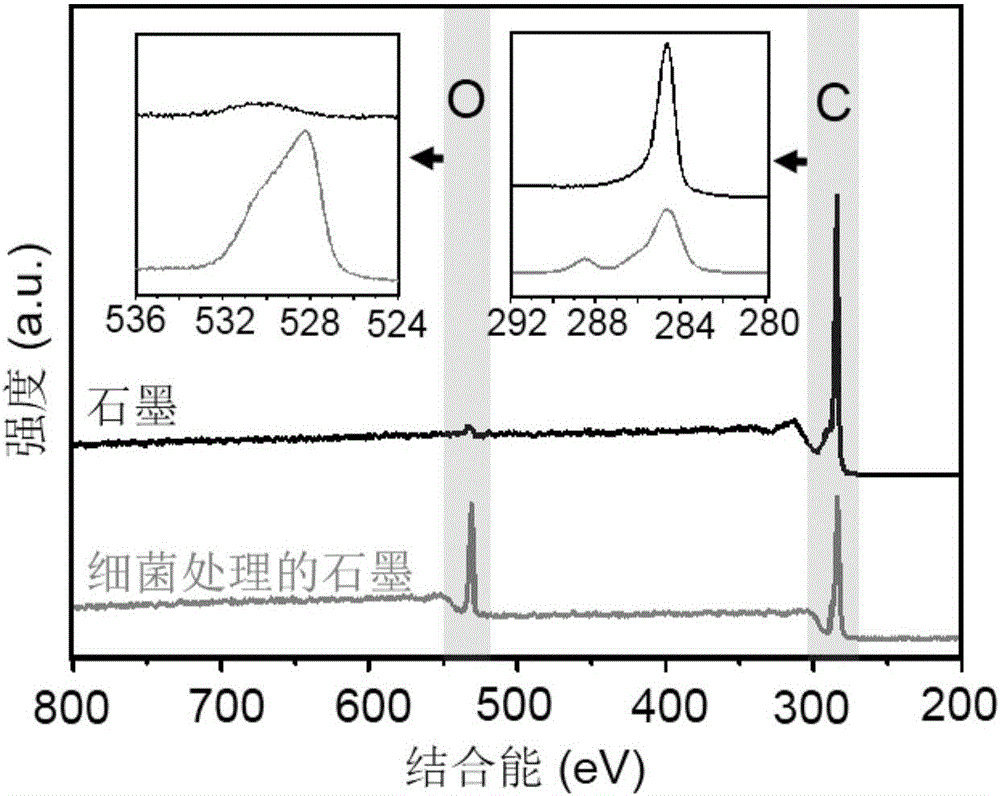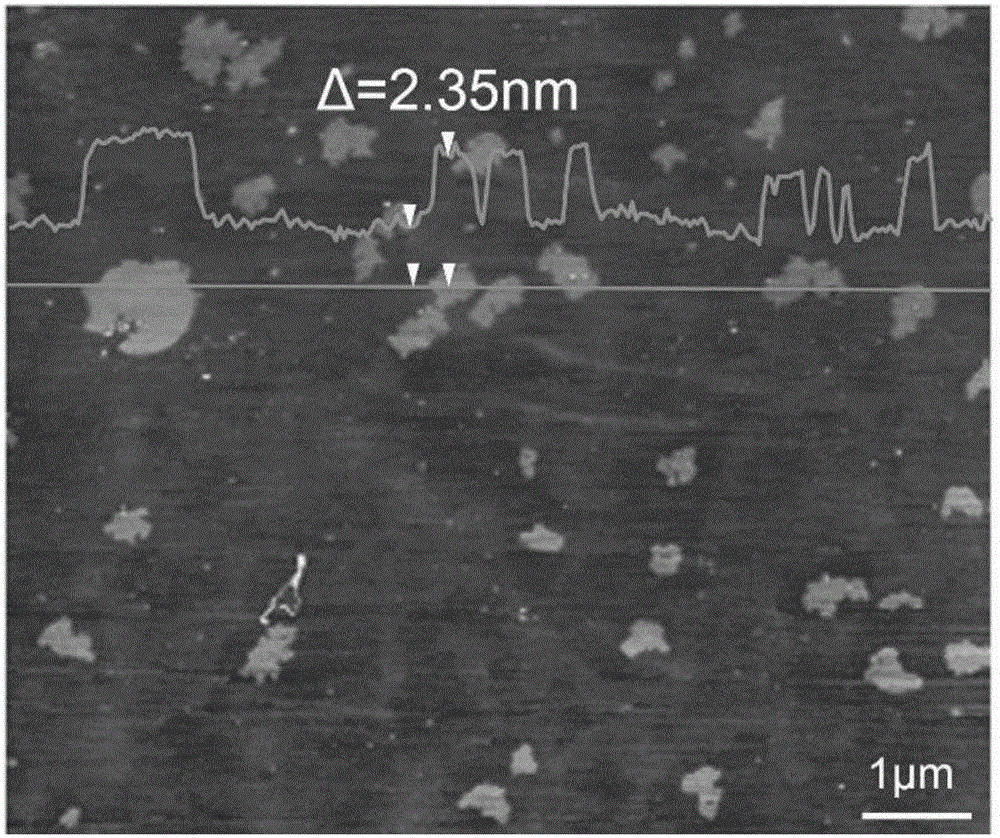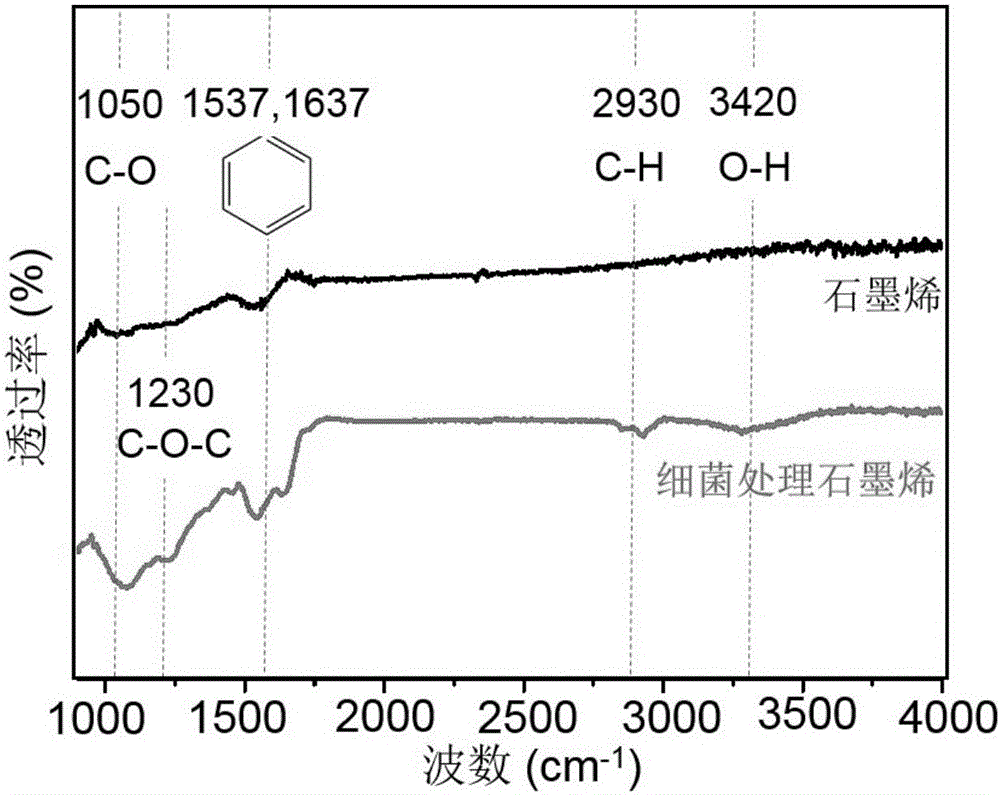Method for oxidizing and degrading graphite material through naphthalene degrading bacteria
A graphite material and bacterial oxidation technology, applied in the field of environmental biology, can solve the problems of expensive high-efficiency enzymes, difficulty in large-scale application, and difficulty in maintaining activity, and achieve the effects of strong bacterial viability, avoiding environmental problems, and rapid bacterial proliferation
- Summary
- Abstract
- Description
- Claims
- Application Information
AI Technical Summary
Problems solved by technology
Method used
Image
Examples
Embodiment 1
[0035] A kind of method of using naphthalene degrading bacteria to oxidize and degrade graphite material of the present invention, concrete implementation method is as follows:
[0036] The first step is to prepare inorganic salt medium. Weigh 12.5g (NH 4 ) 2 · SO 4 ,0.1g CaCl 2 ,7.5g KH 2 PO 4 ,5g NaNO 3 ,20g Na 2 HPO 4 and 50mL trace element solution, dissolved in 5L tap water. 1L trace element solution contains 0.083g KI, 0.3g H 2 BO 3 ,0.0025g ZnSO 4 ·7H 2 O, 0.0025g Na 2 MoO 4 2H 2 O, 0.0025g MnSO 4 4H 2 O and 0.0025g CuSO 4 ·5H 2 O.
[0037] In the second step, the above-mentioned inorganic salt culture medium is loaded into a 5L fermenter, and sterilized by steam. Weigh 10 g of naphthalene, dissolve it with 50 mL of hot ethanol, and quickly pour it into the stirring inorganic salt medium to prepare a naphthalene / inorganic salt medium.
[0038] In the third step, add 5% naphthalene-degrading bacteria solution to the naphthalene / inorganic salt medium...
Embodiment 2
[0046] A kind of method of using naphthalene degrading bacteria to oxidize and degrade graphite material of the present invention, concrete implementation method is as follows:
[0047] In the first step, weigh 0.3g (NH 4 ) 2 · SO 4 ,0.004g CaCl 2 ,0.3g KH 2 PO 4 ,0.2g NaNO 3 ,0.8g Na 2 HPO 4 , dissolved in 200mL tap water, put into a 1L Erlenmeyer flask and mixed with 2mL trace element solution. 1L trace element solution contains 0.083g KI, 0.3g H 2 BO 3 ,0.0025g ZnSO 4 ·7H 2 O, 0.0025g Na 2 MoO 4 2H 2 O, 0.0025g MnSO 4 4H 2 O and 0.0025g CuSO 4 ·5H 2 O.
[0048] In the second step, the inorganic salt culture in the first step is sterilized for 20 minutes under the condition of 120° C. in an autoclave. Add 0.4 g of naphthalene dissolved in hot ethanol to the culture medium, add 10 mL of naphthalene-degrading bacteria liquid, and culture on a shaker at 30°C and 180 rpm for 36 hours.
[0049] The third step is to take 0.1g of graphene, add 5mL of sterilized...
Embodiment 3
[0054] In the first step, weigh 0.75g (NH 4 ) 2 · SO 4 ,0.01g CaCl 2 ,0.75g KH 2 PO 4 ,0.5g NaNO 3 ,2g Na 2 HPO 4 and 5mL trace element solution, with 500mL tap water solution, placed in a 2L Erlenmeyer flask. 1L trace element solution contains 0.083g KI, 0.3g H 2 BO 3 ,0.0025g ZnSO 4 ·7H 2 O, 0.0025g Na 2 MoO 4 2H 2 O, 0.0025g MnSO 4 4H 2 O and 0.0025g CuSO 4 ·5H 2 O.
[0055] In the second step, dissolve 1 g of naphthalene in 10 mL of hot ethanol, sterilize the inorganic salt medium prepared in the first step, insert 20 mL of naphthalene-degrading bacteria liquid, and cultivate it on a shaking table at 35°C and 200 rpm 24h.
[0056] In the second step, take 0.2g of graphene oxide, add 50mL of sterilized water, and ultrasonically disperse in a water bath for 15 minutes, mix it with the naphthalene-degrading bacteria solution being cultivated, and continue to cultivate for 14 days.
[0057] The third step is to centrifuge the cultured bacterial liquid at 1...
PUM
| Property | Measurement | Unit |
|---|---|---|
| Thickness | aaaaa | aaaaa |
Abstract
Description
Claims
Application Information
 Login to View More
Login to View More - R&D
- Intellectual Property
- Life Sciences
- Materials
- Tech Scout
- Unparalleled Data Quality
- Higher Quality Content
- 60% Fewer Hallucinations
Browse by: Latest US Patents, China's latest patents, Technical Efficacy Thesaurus, Application Domain, Technology Topic, Popular Technical Reports.
© 2025 PatSnap. All rights reserved.Legal|Privacy policy|Modern Slavery Act Transparency Statement|Sitemap|About US| Contact US: help@patsnap.com



